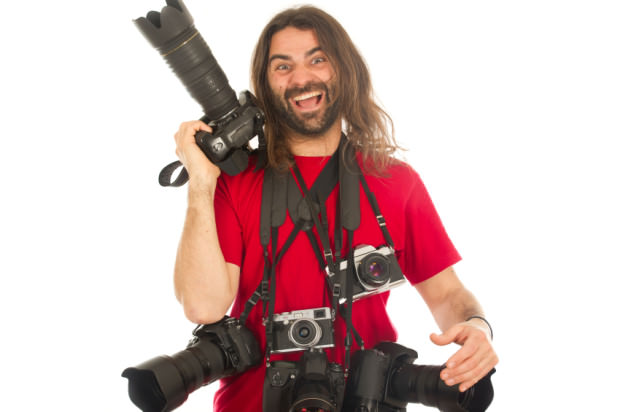 Built-in Flash
Built-in Flash
Photos taken with the built-in flash are hardly ever flattering. The directional light makes people look terrible, the light falloff is dramatic, subjects in the foreground are sometimes washed out, and subjects in the background are sometimes in the dark. This is not always the photographer's fault. Some blame can be put on the camera companies who create digital cameras that use flash in unnecessary situations and make it confusing for many consumers to figure out how to turn the flash off. On the other hand, there are those who carry a full-frame DSLR and use the pop-up flash. This makes professionals and amateurs alike cringe. Once you've seen how much more beautiful and natural an off-camera flash can look, there's little reason to ever use your pop-up.
HDR
High Dynamic Range imaging, or HDR, is a very controversial subject in photography. Many like the surreal effect it can add to photos, while others think it degrades good photography and looks cartoony. There are also many photographers that fall along the spectrum between these two extremes. Some use a very subtle HDR to overcome their camera's limitations. Even if you don't have a strong opinion on the matter, the constant arguing over the subject can be annoying. A question about HDR or a new HDR image will almost always spark a debate.
Vignetting and Filters
Another highly controversial topic is the Instagram movement and the obsession with using filters on images. Many professionals think this is uncreative and ridiculous. Heavy vignetting, sepia, high contrast, lo-fi, cross-processing, grain, and film-eque filters are all very popular and equally annoying to many. Many consumers are also beginning to admire this look and professionals are reluctantly folding and editing their images as such to please their clients. Perhaps what is really bothering photographers about this movement is the fact that they have spent years learning about photography to become a real photographer and these Instagrammers throw a filter onto an image and call themselves the same.
Obsession With New Gear
There are, by far, too many “photographers” out there who sit at their computers and obsess over the latest and greatest photo gear while their own camera sits on the same desk collecting dust. Many of these people are the same that you will find in forums arguing over megapixels, corner sharpness, barrel distortion, MTF charts, and how they are the only ones that really know the difference between ppi and dpi. The point is, these pseudo photographers like to argue a lot about photography, but often do very little actual photographing, making them more of nuisances than anything else.
Fix It In Photoshop
Since the event of digital post-processing, the mentally of shoot it now, fix it later has gotten worse and worse. While digital editing software does give photographers a lot of control over the look of their final image, it doesn't mean that they can turn just any photo into a great photo. Many have said that you can make a great image look better in Photoshop, but you can't make a bad image look good. Perhaps this depends on your definition of a good and bad image. Just because an image is a little overexposed, doesn't necessarily mean it's bad. It could still have a lot of potential, and Photoshop could help bring out that potential. But photographers shouldn't be using this software as a crutch to fix their mistakes, but rather a tool for further improvement.
Professional Know-It-Alls
This doesn't apply to all professional photographers, but there is that handful that think they know everything. They have a perfect set-up and work flow for their business and just because it works perfectly for them, they think that it's perfect for everybody. These pros may tell you to always shoot in RAW, to not worry about high ISO settings because there's software for that, to never compress your images, to make sure your monitor is color calibrated, to insure all of your photography equipment, and to never do any job for free. While these are all great suggestions, they are not necessary for everyone. Maybe you just want some snapshots, and you don't want to process a hundred RAW files. Maybe you want to print your images large, so you want to use the lowest ISO possible. Maybe you don't ever want to print images, so color calibrating your monitor is not a top priority. Professional do know a lot, so ignoring them completely would be a poor choice. But believing everything they say to do is a must is also not the best idea.
Also Read: 41 REASONS WHY YOU SHOULDN’T DATE A PHOTOGRAPHER
Recommended Reading:
- 2013 Photographer's Market: The Most Trusted Guide to Selling Your Photography
- How to Create Stunning Digital Photography
- Best Business Practices for Photographers
- The Fast Track Photographer Business Plan: Build a Successful Photography Venture from the Ground Up
- Group Portrait Photography Handbook
- 500 Poses for Photographing Women
- The Best of Family Portrait Photography: Professional Techniques and Images
- 500 Poses for Photographing Group Portraits
- Selling Your Photography: How to Make Money in New and Traditional Markets
- Starting Your Career as a Freelance Photographer
- Photographer's Survival Manual: A Legal Guide for Artists in the Digital Age
- Legal Handbook for Photographers: The Rights and Liabilities of Making Images
- Taking Stock: Make money in microstock creating photos that sell
- Going Pro: How to Make the Leap from Aspiring to Professional Photographer
Image credit:stockstudioX
Written by Spencer Seastrom
